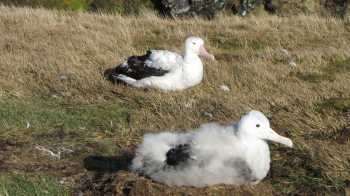It has been known for some time that at least some species of Southern Ocean albatrosses, such as the Wandering Diomedea exulans, have unexpectedly high levels of mercury (in the toxic form of methylmercury) in their bodies and feathers, seemingly without the deleterious effects recorded in some birds with lower levels. But is has not been completely clear whether the sources of these high levels are natural or anthropogenic.
As often seems to be the case, the answer seems to be both, according to recent research on mercury levels in waters of the Southern Ocean by Daniel Cossa (French Research Institute for Exploration of the Sea, La Seyne sur Mer, France) and colleagues (click here)
"The high mercury levels are due to the upwelling of ocean currents and the high levels of bacteria which turn mercury into methylmercury. Once it is in the water it slowly starts getting incorporated into the food web and the higher you go up in the food web the more and more concentrated it becomes. So by the time you get to the larger animals like albatross or petrels or seals or large fish, it is reaching very high levels."
The long lives of albatrosses allow mercury to accumulate to increasingly high levels with age, and their slow moult patterns and females laying single eggs at sometimes more than annual intervals are also thought to be important determinants in the high concentrations found in their tissues.

Wandeing Albatross and chick at Marion Island
Photograph by John Cooper
Click here to read about increasing levels of methylmercury in the Black-footed Albatross Phoebastria nigripes of the North Pacific, thought due to anthropogenic pollution.
Selected references:
Cossa, D., Heimbürger, L.-E., Lannuzel, D., Rintoul, S.R., Butler, E.C.V., Bowie, A.R., Averty, B., Watson, R.J. & Remenyi, T. 2011 Mercury in the Southern Ocean. Geochimica et Cosmochimica Acta 75: 4037-4052.
Hindell, M.A., Brothers, N. & Gales, R. 1999. Mercury and cadmium concentrations in the tissues of three species of southern albatrosses. Polar Biology 22: 102-108.
Lock, J.W., Thompson, D.R., Furness, R.W. & Bartle, J.A 1992. Metal concentrations in seabirds of the New Zealand region. Environmental Pollution 75: 289-300.
Muirhead S.J. & Furness, R.W. 1988. Heavy metal concentrations in the tissues of seabirds from Gough Island, South Atlantic Ocean. Marine Pollution Bulletin 16: 278-283.
Thompson, D.R., Furness, R.W. & Lewis, S.A. 1993. Temporal and spatial variation in the mercury concentrations in some albatrosses and petrels from the sub-Antarctic. Polar Biology 13: 239-244.
John Cooper, ACAP Information Officer, 13 January 2012

 English
English  Français
Français  Español
Español